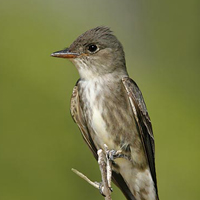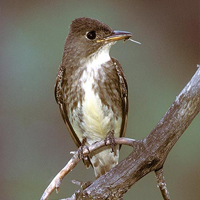Olive-sided flycatcher
Scientific name: Contopus cooperi


Cover photos credit: Brian E. Small (all photos)
Status
Special Concern
“Special Concern” means the species lives in the wild in Ontario, is not endangered or threatened, but may become threatened or endangered due to a combination of biological characteristics and identified threats.
Date added to the Species at Risk in Ontario List
September 10, 2009
Read the most recent assessment report (PDF)
What it looks like
The Olive-sided flycatcher is a medium- sized songbird about 18-20 cm long. Its name reflects its appearance, with the feathers along its sides and back a deep brownish olive-gray colour against a white front. They are often seen perching at the top of tall trees, where they wait for flying insects (their prey) to pass by. They have a loud, three note whistle that sounds like they are singing “quick, three beers.”
Where it lives
The Olive-sided flycatcher is most often found along natural forest edges and openings. It will use forests that have been logged or burned, if there are ample tall snags and trees to use for foraging perches.
Olive-sided flycatchers’ breeding habitat usually consists of coniferous or mixed forest adjacent to rivers or wetlands. In Ontario, Olive-sided flycatchers commonly nest in conifers such as White and Black Spruce, Jack Pine and Balsam Fir.
Where it’s been found in Ontario
The Olive-sided flycatcher has a broad breeding range across Canada and the western and northeastern United States. Just over half the range is found in Canada, where it breeds in every province and territory except Nunavut. Its breeding population is most dense along the west coast from southern British Columbia to California. In Ontario, it is widely distributed throughout the central and northern areas of the province.
In late summer, Olive-sided flycatchers undertake an amazingly long migration to wintering grounds in Panama and the Andes Mountains from Venezuela to Peru and Bolivia.
What threatens it
The cause of Olive-sided flycatcher decline is unclear. Likely threats to the species include habitat loss and alteration of both breeding and wintering grounds. There is some evidence to suggest that individuals breeding in managed forests have lower nest success compared to those breeding in natural forest stands. Olive-sided Flycatchers may also be declining because of declining insect prey.
Action we are taking
Special concern species do not receive species or habitat protection.
What you can do
Report a sighting
- Report a sighting of an endangered animal or plant to the Natural Heritage Information Centre. Photographs with specific locations or mapping coordinates are always helpful.
- Bird Studies Canada is working to advance the understanding, appreciation and conservation of wild birds and their habitat in Ontario and elsewhere; for more information on how you can help, visit: www.bsc-eoc.org
Volunteer
Volunteer with your local nature club or provincial park to participate in surveys or stewardship work focused on species at risk.
Be a good steward
Private land owners have a very important role to play in species recovery. You may be eligible for stewardship programs that support the protection and recovery of species at risk and their habitats.
Report illegal activity
Report any illegal activity related to plants and wildlife to
Quick facts
- Nesting males and females aggressively defend their nest by dive-bombing and bill-snapping at potential predators such as other birds and squirrels
- The loud and distinct “quick, three beers” song of the Olive-sided flycatcher can be heard from up to a kilometre away
- The Olive-sided flycatcher makes dashing and swooping flights from its high perch to catch its prey, flying insects; this type of behaviour is called “sallying” or “yo-yo flight.”